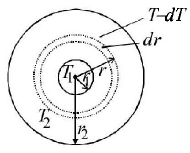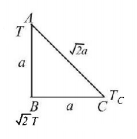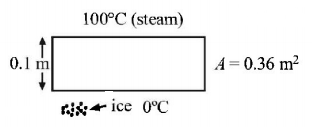1.
The figure shows a system of two concentric spheres of radii $${{r_1}}$$ and $${{r_2}}$$ are kept at temperatures $${{T_1}}$$ and $${{T_2}},$$ respectively. The radial rate of flow of heat in a substance between the two concentric spheres is proportional to
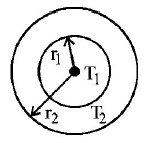
A.
$$ln\left( {\frac{{{r_2}}}{{{r_1}}}} \right)$$
B.
$$\frac{{\left( {{r_2} - {r_1}} \right)}}{{\left( {{r_1}{r_2}} \right)}}$$
C.
$${\left( {{r_2} - {r_1}} \right)}$$
D.
$$\frac{{{r_1}{r_2}}}{{\left( {{r_2} - {r_1}} \right)}}$$
Answer :
$$\frac{{{r_1}{r_2}}}{{\left( {{r_2} - {r_1}} \right)}}$$
2. Which of the following circular rods, (given radius $$r$$ and length $$l$$) each made of the same material and whose ends are maintained at the same temperature will conduct most heat ?
A.
$$r = 2{r_0};l = 2{l_0}$$
B.
$$r = 2{r_0};l = {l_0}$$
C.
$$r = {r_0};l = {l_0}$$
D.
$$r = {r_0};l = 2{l_0}$$
Answer :
$$r = 2{r_0};l = {l_0}$$
3. The two ends of a rod of length $$L$$ and a uniform cross-sectional area $$A$$ are kept at two temperatures $${T_1}$$ and $${T_2}\left( {{T_1} > {T_2}} \right).$$ The rate of heat transfer, $$\frac{{dQ}}{{dt}},$$ through the rod in a steady state is given by
A.
$$\frac{{dQ}}{{dt}} = \frac{{KL\left( {{T_1} - {T_2}} \right)}}{A}$$
B.
$$\frac{{dQ}}{{dt}} = \frac{{K\left( {{T_1} - {T_2}} \right)}}{{LA}}$$
C.
$$\frac{{dQ}}{{dt}} = KLA\left( {{T_1} - {T_2}} \right)$$
D.
$$\frac{{dQ}}{{dt}} = \frac{{KA\left( {{T_1} - {T_2}} \right)}}{L}$$
Answer :
$$\frac{{dQ}}{{dt}} = \frac{{KA\left( {{T_1} - {T_2}} \right)}}{L}$$
4. A long metallic bar is carrying heat from one of its ends to the other end under steady-state. The variation of temperature $$\theta $$ along the length $$x$$ of the bar from its hot end is best described by which of the following figures?
A.
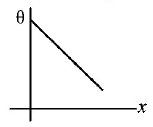

B.
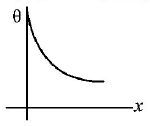

C.
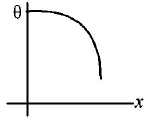

D.
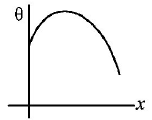

Answer :


5.
Two rods $$A$$ and $$B$$ of different materials are welded together as shown in figure. Their thermal conductivities are $${K_1}$$ and $${K_2}.$$ The thermal conductivity of the composite rod will be :
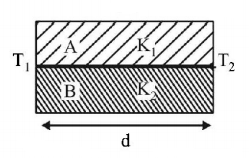
A.
$$\frac{{3\left( {{K_1} + {K_2}} \right)}}{2}$$
B.
$${{K_1} + {K_2}}$$
C.
$$2\left( {{K_1} + {K_2}} \right)$$
D.
$$\frac{{{K_1} + {K_2}}}{2}$$
Answer :
$$\frac{{{K_1} + {K_2}}}{2}$$
6.
The temperature of the two outer surfaces of a composite slab, consisting of two materials having co-efficients of thermal conductivity $$K$$ and $$2\,K$$ and thickness $$x$$ and $$4\,x,$$ respectively, are $${T_2}$$ and $${T_1}\left( {{T_2} > {T_1}} \right).$$ The rate of heat transfer through the slab, in a steady state is $$\left( {\frac{{A\left( {{T_2} - {T_1}} \right)K}}{x}} \right)f.$$ with $$f$$ equal to
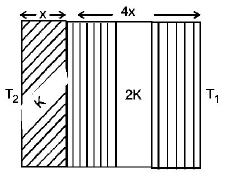
A.
$$\frac{2}{3}$$
B.
$$\frac{1}{2}$$
C.
1
D.
$$\frac{1}{3}$$
Answer :
$$\frac{1}{3}$$
7. Consider two rods of same length and different specific heats $$\left( {{s_1},{s_2}} \right),$$ thermal conductivities $$\left( {{K_1},{K_2}} \right)$$ and areas of cross-section $$\left( {{A_1},{A_2}} \right)$$ and both having temperatures $$\left( {{T_1},{T_2}} \right)$$ at their ends. If their rate of loss of heat due to conduction are equal, then
A.
$${K_1}{A_1} = {K_2}{A_2}$$
B.
$$\frac{{{K_1}{A_1}}}{{{s_1}}} = \frac{{{K_2}{A_2}}}{{{s_2}}}$$
C.
$${K_2}{A_1} = {K_1}{A_2}$$
D.
$$\frac{{{K_2}{A_1}}}{{{s_2}}} = \frac{{{K_1}{A_2}}}{{{s_1}}}$$
Answer :
$${K_1}{A_1} = {K_2}{A_2}$$
8. Three rods of identical cross-sectional area and made from the same metal from the sides of an isosceles triangle $$ABC,$$ right-angled at $$B.$$ The points $$A$$ and $$B$$ are maintained at temperatures $$T$$ and $$\left( {\sqrt 2 } \right)$$ $$T$$ respectively. In the steady state, the temperature of the point $$C$$ is $${T_c}.$$ Assuming that only heat conduction takes place, $$\frac{{{T_c}}}{T}$$ is
A.
$$\frac{1}{{2\left( {\sqrt 2 - 1} \right)}}$$
B.
$$\frac{3}{{\sqrt 2 + 1}}$$
C.
$$\frac{1}{{\sqrt 3 \left( {\sqrt 2 - 1} \right)}}$$
D.
$$\frac{1}{{\sqrt 2 + 1}}$$
Answer :
$$\frac{3}{{\sqrt 2 + 1}}$$
9. A slab of stone of area $$0.36\,{m^2}$$ and thickness $$0.1\,m$$ is exposed on the lower surface to steam at $${100^ \circ }C.$$ A block of ice at $${0^ \circ }C$$ rests on the upper surface of the slab. In one hour $$4.8\,kg$$ of ice is melted. The thermal conductivity of slab is : (Given latent heat of fusion of ice $$ = 3.36 \times {10^5}\,J\,k{g^{ - 1}}.$$ ):
A.
$$1.24\,J/{m^ \circ }C$$
B.
$$1.29\,J/{m^ \circ }C$$
C.
$$2.05\,J/{m^ \circ }C$$
D.
$$1.02\,J/{m^ \circ }C$$
Answer :
$$1.24\,J/{m^ \circ }C$$
10. Which one of the following processes depends on gravity ?
A.
Conduction
B.
Convection
C.
Radiation
D.
None of these
Answer :
Convection
